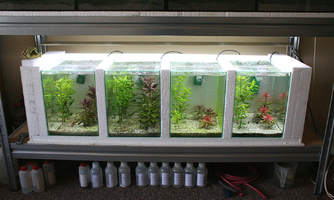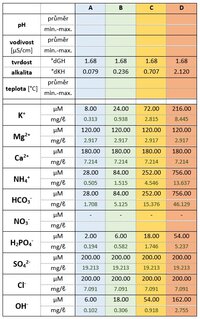_Maq_
Member
Dear colleagues,
let me invite you to collaboration on my upcoming experiment.
My workshop looks like this:

Four tanks, each 20 litres net, arranged to maintain identical conditions regarding lighting, temperature, etc. The only difference is mineral composition of water:

My method of mineralization is called, if I’m not mistaken, “front loading”. I’m adding 50 % of indicated minerals in 8-day intervals while performing 50 % water change. As a result, actual concentrations (esp. N, P & K) are slightly lower.
I’m dosing micros usually two days before water change. I’m not going to discuss the amounts of micros because I’m of the opinion that this is strictly individual and visible symptoms are our sole clue. However, I always dose micros identically in all tanks at the same time.
Chemicals used: KOH, KH2PO4, NH4HCO3, MgSO4, MgCl2, CaCl2. Micros: FeCl3, MnSO4, ZnSO4, CuSO4, H3BO3.
Projected plant species:
monocots: Cryptocoryne wendtii Rubella, Egeria densa, Sagittaria platyphylla, Vallisneria spiralis, Tonina fluviatilis.
dicots: Ammannia pedicellata Gold, Bacopa lanigera, Hygrophila corymbosa siamensis Brown, Hygrophila lancea, Rotala rotundifolia Orange Juice, Rotala wallichii.
Now, what is the aim of this experiment?
The tanks are called A – lean, B – moderate, C – Barr, D – insane.
As you can see, NPK dosing is sharply increasing from A to D, and all the nitrogen is in ammoniacal form! So, the first aim is to see what such an insane amount of nutrients (eq. 46 mg NO3 per litre in D) will do. Will the plants grow faster, better? Shall they get damaged by ammonium (“ammonia burn”)? Will there be more algae in more fertilized tanks (with ammonium)?
I don’t know. I’ve never tried such truly insane amounts of nutrients.
At the same time, this design is also focused on K:Mg:Ca ratios, which we’ve discussed quite recently in another thread. As you see, the amounts of Mg and Ca are identical in all tanks, while K is increasing (maintaining fixed ratio with N and P). Will we encounter signs of deficiency of K, Mg, or Ca in any tanks?
An important question for Estimative Index users: Is the mineral composition of the tank C acceptable to be called "Barr – Estimative Index"? Of course, with the exception of ammonium (eq. 16 mg NO3 per litre). Dosing ammonium instead of nitrates makes the point here, because EI users never dose ammonium and maintain that ammonium causes algae.
I promise that I will not call the results of this experiment a proof of this or that. Rather, let’s take them for indications, suggestions, broadening our understanding of aforementioned questions.
Your opinion and suggestions are warmly welcome! Please, take part in designing this experiment as useful as possible.
let me invite you to collaboration on my upcoming experiment.
My workshop looks like this:

Four tanks, each 20 litres net, arranged to maintain identical conditions regarding lighting, temperature, etc. The only difference is mineral composition of water:

My method of mineralization is called, if I’m not mistaken, “front loading”. I’m adding 50 % of indicated minerals in 8-day intervals while performing 50 % water change. As a result, actual concentrations (esp. N, P & K) are slightly lower.
I’m dosing micros usually two days before water change. I’m not going to discuss the amounts of micros because I’m of the opinion that this is strictly individual and visible symptoms are our sole clue. However, I always dose micros identically in all tanks at the same time.
Chemicals used: KOH, KH2PO4, NH4HCO3, MgSO4, MgCl2, CaCl2. Micros: FeCl3, MnSO4, ZnSO4, CuSO4, H3BO3.
Projected plant species:
monocots: Cryptocoryne wendtii Rubella, Egeria densa, Sagittaria platyphylla, Vallisneria spiralis, Tonina fluviatilis.
dicots: Ammannia pedicellata Gold, Bacopa lanigera, Hygrophila corymbosa siamensis Brown, Hygrophila lancea, Rotala rotundifolia Orange Juice, Rotala wallichii.
Now, what is the aim of this experiment?
The tanks are called A – lean, B – moderate, C – Barr, D – insane.
As you can see, NPK dosing is sharply increasing from A to D, and all the nitrogen is in ammoniacal form! So, the first aim is to see what such an insane amount of nutrients (eq. 46 mg NO3 per litre in D) will do. Will the plants grow faster, better? Shall they get damaged by ammonium (“ammonia burn”)? Will there be more algae in more fertilized tanks (with ammonium)?
I don’t know. I’ve never tried such truly insane amounts of nutrients.
At the same time, this design is also focused on K:Mg:Ca ratios, which we’ve discussed quite recently in another thread. As you see, the amounts of Mg and Ca are identical in all tanks, while K is increasing (maintaining fixed ratio with N and P). Will we encounter signs of deficiency of K, Mg, or Ca in any tanks?
An important question for Estimative Index users: Is the mineral composition of the tank C acceptable to be called "Barr – Estimative Index"? Of course, with the exception of ammonium (eq. 16 mg NO3 per litre). Dosing ammonium instead of nitrates makes the point here, because EI users never dose ammonium and maintain that ammonium causes algae.
I promise that I will not call the results of this experiment a proof of this or that. Rather, let’s take them for indications, suggestions, broadening our understanding of aforementioned questions.
Your opinion and suggestions are warmly welcome! Please, take part in designing this experiment as useful as possible.



